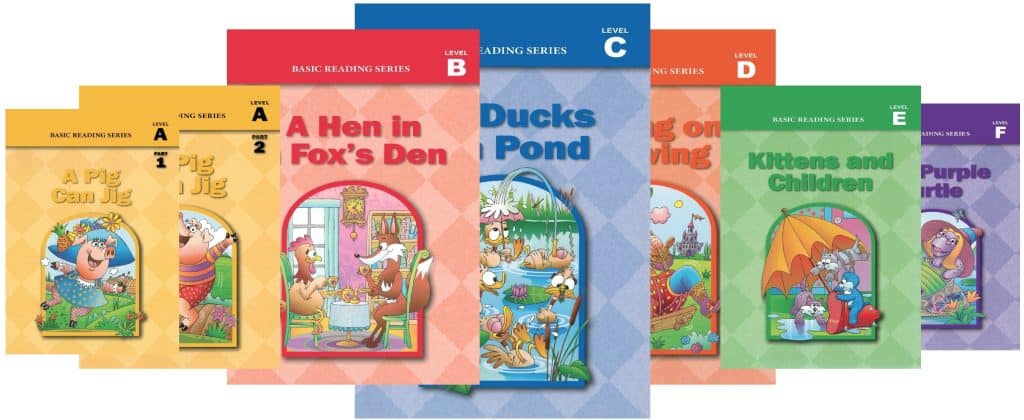
Why is the Basic Reading Series So Successful?
Parents, homeschoolers, and teachers can now instruct 5- to 8-year-olds to read using the BASIC READING SERIES, a proven whole-word phonics program used by millions of children. Whether for individual or group instruction, BRS allows children to progress at their own pace until they are confident, independent readers.
The BASIC READING SERIES has a dedicated and faithful following among teachers and parents who want an alternative to discredited reading programs. The sixth edition of BRS keeps the program up to date without altering its time-tested rationale and sequence of word patterns. BRS retains its light and humorous touch and emphasis on honesty, courage, kindness, loyalty, and cooperation. And the series is now available in a low-cost, paperback edition!
The BASIC READING SERIES consists of seven readers and six workbooks with instructions for parents and teachers. BRS may be purchased from leading homeschool suppliers, educational bookstores, and on Amazon.
Whole-Word Phonics Simplifies Learning
Where the BASIC READING SERIES differs from traditional phonics practice is in the methods by which it reaches the same goal. Traditional phonics practice will typically ask children to “sound out” single letters first (“b says buh”) and then “blend” individual letter sounds into whole words (“buh-ih-tuh says bit”).
The authors found it more effective and realistic to start children off with whole words (meaningful combinations of letters) and let them discover how individual letter-changes affect word pronunciation. In this way, children always see letters in their true perspective as parts of a whole, interacting with the other parts. They learn how the letter b functions in a particular situation instead of “what the letter b says.”
Moreover, an unnecessary intermediate step is avoided. Why have children translate the letters b-i-t into a false language first (buh-ih-tuh) and then retranslate that into the word bit? Experience shows that most children can go directly from the letters b-i-t to the word bit without the extra step.
Inductive Method Enhances Discovery
The BASIC READING SERIES introduces the child first to words like man, ran, and pan, using them in sentences, drills, and exercises that provide many opportunities for observation and discovery. The child sees that the -an sound and spelling are constant in these words while the introductory consonant varies. Next, a series of -at words like mat, rat, and hat is introduced. The child begins to see that certain initial consonants have the same effect here as they had in the -an words. Now an early inductive conclusion becomes possible: confronted with the letters p-a-t, the child discovers that it starts like pan and ends like mat. Therefore, it must be pat. The child has figured out a word independently!
Thus, starting with the simplest and progressing to more complex patterns, the program gradually accumulates more and more word patterns from which children can draw reliable generalizations of their own about the connections between spellings and sounds. It gives the children plentiful opportunities to develop confidence and automatic responses to each pattern and to apply their generalizations to new words.
Controlled Vocabulary Builds Confidence
The reading vocabulary of the BASIC READING SERIES is closely controlled according to spelling patterns. These patterns are revealed to the learner one by one so that the language that confronts the student at each stage is regular, consistent, and predictable. Fortunately, English spelling does contain a core of consistent patterns for representing most sounds, despite the apparent inconsistencies. Linguistic science has helped to classify these, and classroom trial and error enabled the authors to sequence them for maximally efficient learning. The controlled release of vocabulary, organized by spelling patterns, ensures that children will encounter the unusual and nonconforming patterns only when they are ready for them — after they feel secure with the regular and reliable features of the language, and after they have read a large body of complete stories, thus building a background of confidence and solid achievement.